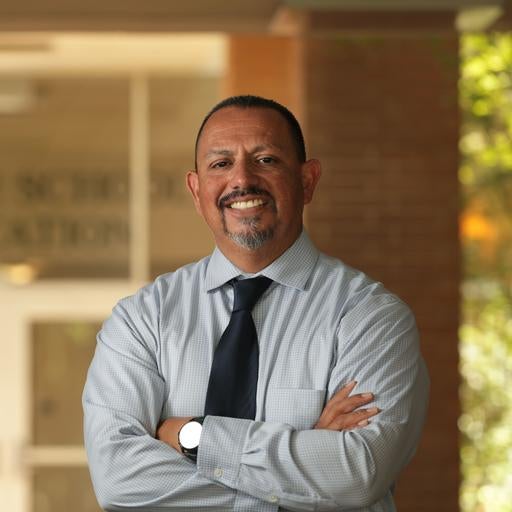
At the center of Interim Dean Louie Rodriguez’s work is promoting student success, and since the start of the 2021 school year, he has visited more than 10 classes and met with over 300 students in the School of Education. His goal is not only to connect with SOE students, but to encourage them to use the tools and resources to successfully guide them in their educational journeys…with a little help from Dora the Explorer.

Dr. Rodriguez, you have used the Dora the Explorer and her mochila, or backpack, as a metaphor when visiting classes. Could you explain this to us?
Dora the Explorer is amazing in so many ways. She’s bilingual, brave, proud of her family, connected to her culture, and always a leader. She and her sidekick Boots spend much of their time solving problems and helping people. What has always struck me is her use of that little purple backpack, the mochila. In various situations, she exercises her leadership by reaching into her mochila to pull out ladders, life jackets, rope, umbrellas, and various other useful tools at just the right time.
Over the last month, I’ve been using the mochila as a metaphor as I talk with various groups of students, especially in the context of the pandemic, the 18-month out-of-school reality, and the return to in-class teaching and learning.
What are the types of resources a student might “carry” in their mochila?
Typically, students—everyone from kindergartners to graduate students—arrive to a new academic year with a backpack full of new supplies such as pencils, erasers, paper and spiral notebooks, glue, and sometimes a learning device.
In addition to these items, I have been encouraging students to think about the other things they bring with them to school in their backpacks—their strengths and assets—and I have been encouraging them to use them as tools to inspire, motivate, and propel them to that next level in their educational journeys.
What are some examples of these strengths and assets that students bring into the classroom?
They bring their families, their culture, and their language in their mochilas. They bring their communities, parents, and ancestors with them. Students brings their educación, parents’ sacrifice, and family ganas that inform their persistence. They bring their resilience, conviction, and tenacity.
I remind students that it is not just them sitting in classes or attending hybrid courses this fall—sitting alongside them are their families, their struggles, and their triumphs. Every single day our students are bringing their family or cultural sayings, advice, and stories with them. They are bringing their personal, family, and ancestral legacies too. At a deeper level, they are bringing a hemispheric legacy of excellence with them that goes back centuries. I tell them that while there continues to be several challenges as we return to in-person learning, we should remind ourselves of our assets and strengths that we bring with us to school every single day.
Whether it is in-person, hybrid, or online teaching and learning, our students are ready to learn, and so are their families, abuelos, and ancestors that they bring with them to class every day. These are not items that can be checked at the door. Conversely, we should be inviting these strengths and assets to bolster the academic and social experience in the classroom. In fact, the knowledge, skills, and experiences that are informed by their culture, family, and communities can make the learning endeavor so much richer.
How can educators apply this metaphor?
The questions become, as educators, are we courageous and visionary-enough to recognize these assets and strengths of our students? Are we willing to be flexible with our practices and policies especially as we return from a very challenging 18 months? Are educators centering the power of story to connect and reconnect with students? At a systemic level, do our systems have the capacity to equitably respond to students’ needs and provide educators with the needed supports to care for themselves in order to effectively serve our students?
It is clear that the pandemic is not over. However, our students are sitting in our classes every day and ready to learn. Every one of those strengths and assets our students bring to the classroom are the keys to academic, personal, and community success this year. When we see our students, let’s remember their backpacks are just as full of richness.